Assistive Technology 2.0: Special Tech

Assistive technology (AT) is a hypernym that includes assistive, adaptive, and rehabilitation devices for people with disabilities. What are the differences between low-, mid-, and high-technology? What’s “hot” in 2013? Special education expert and T&L blogger Vicki Windman shares her insights and interviews other experts to answer these questions and more.
Mark Giufre
In 1996 I “touched” my first desktop computer. After I completed graduate school, I became enamored with technology. I wrote an article for T&L in 2005 titled “Case Study: Special Education.” It coincided with my fascination with the Palm Pilot. We were all busy beaming each other and learning how these assistive technology “gadgets” could enhance learning. But more importantly, we began to reach students with disabilities who were either locked in their heads or unable to write a word.
Turn the clocks forward to 2013, and we now have many more choices to meet the needs of these children. I had the opportunity to interview two education professionals, Mark Giufre, the curriculum and instructional technology specialist at the Wildwood Programs in Albany, NY, and Brian Koffler, general counsel and director of operations and instructional technology of Metaschools in New York, NY.
How has the field of AT changed in the past few years?
Brian Koffler

Koffler: AT in schools wasn’t really being used effectively until about three years ago. In the past, school districts would have to spend upwards of $10,000 for devices like those by DynaVox, a widely-used communication device. Now, the same result is garnered through the use of more affordable tablets like the iPad, which has many functions beyond a simple communication device, and a $200 program like Proloquo2Go. Because of the specificity of today’s applications, there is definitely an app that matches the curricular goals of most schools. In the event that there is not a matching app, most districts can create their own app designed just for their students.
Tools and ideas to transform education. Sign up below.
Vicki Windman: I have been writing about apps aligning to Common Core standards that make it easy for teachers to match both curriculum and standards, as well as meet IEP goals. Districts can also save money creating personal portfolios for students using GoogleDocs and DropBox.
What assistive technology programs are you using and how are you using them?
Giufre: We are no longer sitting in our offices. We are out in the classrooms teaching teachers how to use this new technology. In our school, we use iPads and their built-in accessibility features, SMARTboards, text-to-speech features, and augmentative and alternative communication solutions. We also use apps such as Pictello ($18.99) and First- Then Visual Schedule ($9.99) to increase independence. We also use many personalized and individual solutions including read-aloud options in literacy programs and different styli for input on I-devices. These programs provide opportunities for students to simultaneously engage in the same tasks with other students.
Koffler: We use SMART Boards and Epson interactive projectors for our interactive whiteboard needs. We have begun to attach Apple TVs to most in-class displays to allow mirroring of a number of devices. Our students have access to Mac and PC devices, along with iPads, iPods, Android devices, and Chromebooks.
Why did you choose these technologies?
Koffler: We believe that with the rapid change of technology it is important to make sure that we are not married to one brand or type of device. We want to ensure that our students know how to operate a variety of platforms. While we have brought Macs into some of our schools, we have significantly more PC devices because they are better for operating in large enterprise environments.
What best practices do you recommend for assistive technology?
Koffler: I like to ensure that we have hardware available that teachers can use where appropriate for each child. It is important that those students who will benefit from the technology have it available to them and those students who will be distracted are taught using more traditional means. If there is one thing our teachers should know, it is that technology is there to be a tool to help them deliver THEIR curriculum. It is not there to entertain students or to change what they would teach if the technology were not there.
What are your short- and long-term goals?
Giufre: Our short-term goals would include having all staff members participating and understanding the need for assistive technology as a link to a student’s learning plan, in addition to creating a way to integrate support goals and outcomes for the professional learning community. Specialists with subgroups would be created at each level, working together to achieve common goals with constant communication regarding potential instructive technology solutions and benefits. This PLC would analyze what we have versus what we need, as well as make decisions that are backed by research and data that allow us to make intelligent choices for the long term.
Long-term goals would include constant analysis of what is offered globally to everyone, including very specific items, making sure constant professional development occurs so that technology isn’t “another thing” but rather fully integrated as part the daily routine. Most important, we continually analyze cost versus effectiveness and don’t purchase items without knowing what we already own or looking at more cost-effective alternatives that could provide the same results.
How do schools budget their assistive technology?
Vicki Windman: Schools now have technology budgets, which are divided up between schools. In classrooms such as mine, we require assistive technology in addition to SMARTboards and computers. We need to present our needs and validate why they are needed. Our school chose iPads as one of the major assistive technology pieces of equipment. We also use document cameras to enhance the ability to see objects. We are also given a budget from the special education department to help purchase some of the more costly assistive technology items. This changes yearly based on the student population. We added large keyboards for visually impaired students and larger mice for students who have fine motor needs. It is not like a list of needs for mainstream students where the same books are ordered year after year. We have gone from using Daisy Readers, Neo-Direct (AlphaSmart), and Kurzweil to Dragon Naturally Speaking.
The age of assistive technology is just beginning as the cost of tools drops and access to these tools rises. Most important, these tools are accessible right out of the box, making them fully accessible for all.
ASSISTIVE TECHNOLOGY RESOURCES
LOW TECHNOLOGY
STYLUSES: Styluses are great for cleanliness and access.
• Geekery Styluses for the Disabled ($22-$48): Ivo Becker from Norway has made styluses for any disability fro mouth sticks to Chewy Tubes.
Go Now
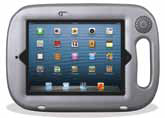
CASES: With the hundreds of cases to choose from it is difficult to make a choice. The criteria for students with disabilities include shock-proof, impact-resistant, waterproof, comfortable to hold, easy to grip, nontoxic, and latex-free.
Ballistic
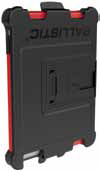
• GoNow Case for the iPad ($59) and the iPad mini ($49): This case is easy to hold with a separate handle. It is designed so the volume can be increased. Another great feature is the magnetic switch on the case to lock/ unlock the iPad.
• Ballistic New iPad and iPad 2 Tough Jacket Series Case ($69.99): This case is made of three layers of strong protection. The Tough Jacket Series has ballistic corners, which means all four corners have extra shock absorption.
iKeyboardTouchfire

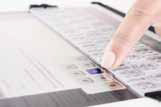
KEYBOARDS: Keyboards are recommended for students who are unable to use either a stylus or finger to “write” on a tablet.
• iKeyboard ($35): This keyboard comes in white or black and sticks right to your iPad keyboard. The keys are slightly raised on the iKeyboard giving the user the feeling of touching a key. There’s no heavy case to carry, and it gets the job done just as efficiently at one-third of the cost of a hard case iPad case and keyboard.
• Touchfire ($49.95): Weighing in at 3/8 of an ounce, this transparent silicone rubber keyboard has magnets that slide onto the iPad keyboard.
Kidz Gear
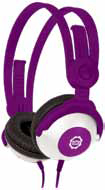
HEADPHONES: Headphones are recommended for students who have sensory processing issues.
• Kidz Gear ($19.99): These colorful headphones feature volume control.
• Califone headphones ($256-$293): These headphones are sold in a variety of cute designs.
MID TECHNOLOGY
Califone

• Logitech Ultra Thin Keyboard ($99): The only wire needed for this keyboard is for charging the keyboard to sync with your Bluetooth. This keyboard is thin and fits the iPad quite easily.
• Boogie Board Rip LCD Writer ($129.95): This tablet can connect with your computer and save your notes in Evernote and other programs. Boogie Board 8.5 ($39.95) is a smaller version but cannot save notes.
Boogie BoardLivescribeLogitech


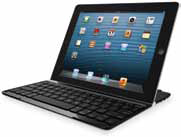
• Livescribe Sky wifi smartpen (2GB Sky, $149.95; 4GB Sky, $199.95; 8 GB Sky, $249.95): This smartpen uses Evernote to sync notes. It is easy to use and a great tool for students with dyslexia and Attention Deficit Disorder. The pen records a lesson while the student uses the Livescribe notebooks.
• HIMS Low Vision Products (749.99): These products are ideal for the blind. These tools include desktop video magnifiers, the Candy Grip visual held magnifier, and a 5.0″ LCD handheld video magnifier.
HARD ASSISTIVE TECHNOLOGY
• Nexus 10 ($399, 16 GB, WiFi only): This system is an Android operating system tablet. It is quite fast for a tablet but its battery drains 50% faster than many consumers would like. If you are looking to enter the tablet world and like Android apps, this tablet is the one to get. Nexus claims you can load Flash using the Firefox browser from the playstore.
• Kindle Fire HD ($299, 8.9” 16GB, WiFi): Some of the perks of the Kindle Fire are good audio and a solid display. On the flip side, the Google apps are missing and replaced with Microsoft’s Bing. Furthermore, there are complaints that the apps take you to the Amazon Appstore making it difficult to download Android apps.
• iPad 2 ($399, 16GB, WiFi only): The iPad 2 price point is the same as the above tablets. The iPad 2 introduced retina display and still is the lightest iPad making it a favorite for iPad users. The only drawback is that the iPad can only be used with iTunes apps and is not compatible with Flash.
